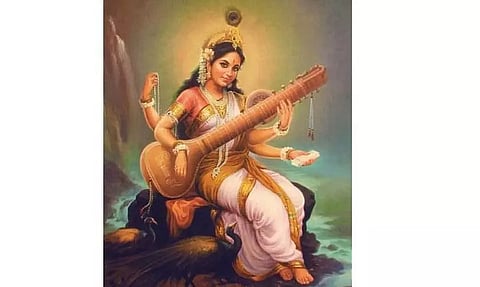
- Home
- Live Blog
- Breaking News
- Top Headlines
- Cities
- NE News
- Sentinel Media
- Sports
- Education
- Jobs

Swagata Padmapati
The advent of Vasant Panchami in India every year marks the beginning of the vasant ritu or the spring season. As per traditional Indian cosmology the fifth day of the "Magha" month is popularly celebrated as Saraswati Mahotsav or Saraswati Puja. The day marks the descent of "Ma Saraswati" on this earthly plane. Ritualistic ceremonies are conducted all over to propitiate the Vedic goddess imbued in white saree who is considered as the supreme embodiment of knowledge and wisdom in Indian culture. The goddess is also worshipped as the consort of Lord Brahma (The creator of the Universe), thus representing the operative aspect of the cosmic existence.
As per popular literature available it is believed that she originated from the mouth of Brahma Dev and hence she is also known as the "Vak Devi", the ultimate manifester of speech in mankind. Many stories narrate different tales of this divine form of the goddess. In one such story she is personified as the ancient river "Saraswati" which existed in the Vedic times as the symbol of purity. In another popular tale she is attributed to the success of getting the divine nectar or Amrit back from the Gandharvas (celestial being) to the devatas of the Swarga Loka. Additionally she is also glorified as the divine mother of the Vedas and finds an esteemed place in the Rig Veda where she is epitomised as the "Best of all the mothers", "Best of all the rivers" and "Best of all the goddess". The Vedas describe her in many ways. In the "Rigveda" she is seen as "Pavaka" which means Agni or fire which when appeased can heighten the fire of intellect and wisdom. In Atharva Veda and Yajur Veda she is invoked as the deity who destroys all forms of maladies and bestows upon food, money, affluence and off springs to the person who has prostrated before her. Likewise many puranic literatures are known to celebrate different aspects of this goddess like for example in the Devi Mahatmya she is worshipped as the slayer of the demons called Rakta Bheeja, Shumba and Nishumba. Another popular tantric literature from Tibet venerates her as Nila Saraswati who is considered to subsume the knowledge of tantra shastra. In Kashmir she is worshipped as Devi Sharada who is a tripartite embodiment of Sharada, Saraswati and Vagdevi bestowing knowledge and learning to the people.
In the popular Indian cultural tradition, she is depicted as a beautiful voluptuous woman clad in white saree seated both on lotus and swan. Each of her four arms holds a scripture, a rosary and a musical instrument called Veena. There is a water pot also known as Kamandalu which is kept near her. Certain photographs also carry an image of a peacock beside her. All of these elements associated with the goddess have a deep symbolic meaning. Being draped in a white saree denotes purity or sattvic tendencies that uphold dharma. White is also the colour which reflects all the other colours of the solar spectrum. Metaphorically, it points to the transcendental consciousness that reflects through knowledge. The voluptuous figure of the beautiful goddess denotes fertility or a bed of creation. The scripture on her hand represents all the Vedas of the Hindu philosophy. The rosary is indicative of the meditative and spiritual qualities. The veena reflects creative sciences and skills. The pot of water in kamandalu reflects the purifying power to discriminate between right and wrong. The water could also mean to depict "Soma" which when drunk liberates one and leads to the realisation of the supreme Brahma. Her vehicle in the form of swan illustrates symbolically that for the quest of knowledge one has to be attuned with consistent efforts just like the bird which looks very calm on the surface but constantly paddles underneath the water to keep itself afloat. Similarly, for knowledge one needs serenity of mind and a constant search for acquisition and improvisation. Lastly the peacock symbolises the splendour of its beautiful plumage and a devourer of snake. The snake can be compared with the kundalini shakti that is present in every human being in its potent form on the base of the spinal chord which when awakened can alchemically transmute the poison of ego into radiance of enlightenment through knowledge.
Additionally an interesting thing to suffice at this point is that the concept of the goddess is also revered equally in other South East Asian countries like for example in Burma she is worshipped as goddess Thurathadi, in Budhhist and Shinto tradition of Japan she is venerated as goddess Benzaiten, in Cambodia she is goddess Vagisvari and Bharati, in Thailand she is goddess Suratsawadi. Thus, it is evident that cultures across the world who emulate the spirit of learning personify knowledge in the form of a revered divinity as their god or goddess.
In an average traditional household of India Devi Saraswati is enshrined deeply as the supreme bestower of knowledge. Elaborate rituals are conducted on this day to initiate children into education. Books, copies, pen, paper, ink are offered at her feet to receive her divine blessings. It is believed that by such offerings the deity gets pleased and confers great creative and intellectual capabilities. Apart from this many educational and financial establishments also worship her with Ma Lakshmi and Ganapati in their boardrooms. The votive representation of the trine is believed to dispel ignorance and bring in clarity and innovation in the work environment which ultimately leads to the realisation of full potential of the institution in all aspects.
Hence to conclude let's all pledge to keep the true fire of knowledge and learning alive in our lives always.